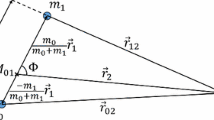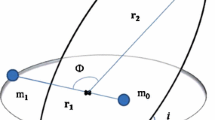Abstract
We analyse the secular interactions of two coplanar planets which are not in mean motion resonances. The analysis is based on a high order (order 12) expansion of the perturbative potential in powers of the eccentricities. The model depends on only two parameters (the ratio of semi-major axis and the mass ratio of the planets) and can be reduced to a one degree of freedom system, allowing for an exhaustive parametric analysis. Following Pauwels [Pauwels T.: 1983, Celet. Mech. & Dyn. Astro. 30, 229–247] we map the phase space on a sphere, avoiding in this way the artificial singularities introduced by other mappings. We show that the 12 order expansion is able to describe correctly most of the exosolar planetary systems discovered so far, even if the eccentricities of these planets are considerably larger than the eccentricities of our own solar system. The expansion is even able to reproduce, at moderate eccentricities, the secular resonances discovered numerically by Michtchenko and Malhotra [Michtchenko, T. A. and Malhotra, R.: 2004, Icarus 168, 237–248] at moderate to large eccentricities.
Similar content being viewed by others
References
N. Abu-el-Ata J. Chapront (1975) ArticleTitle‘Développements analytiques de l’inverse de la distance en mécanique céleste’ A&A 38 57–66 Occurrence Handle1975A&A....38...57A
Brouwer, D. and Clemence, G. M.: (1961), Methods of Celestial Mechanics, Academic Press
J. Henrard (1988) ArticleTitle‘Note on the reducing transformation and secular coupling’ Celest. Mech. 45 327–331 Occurrence Handle1989CeMec..45..327H Occurrence Handle90h:70014
J. Henrard A.-S. Libert (2005) ‘The secular planetary three body problem revisited’ Knežević Milani (Eds) Dynamics of Population of Planetary Systems. Cambridge U.P. 49–54
Laskar, J.: (1990), ‘Systèmes de variables et éléments’, In: D. Benest and C. Froeschlé (eds), Les méthodes modernes de la mécanique céleste, editions Frontière, pp. 63–87
T.A. Michtchenko S. Ferraz-Mello (2001) ArticleTitle‘Modelling the 5:2 Mean-Motion Resonance in the Jupiter–Saturn planetary System’ Icarus 149 357–374 Occurrence Handle10.1006/icar.2000.6539 Occurrence Handle2001Icar..149..357M
T.A. Michtchenko R. Malhotra (2004) ArticleTitle‘Secular Dynamics of the v Andromedae System’ Icarus 168 237–248 Occurrence Handle10.1016/j.icarus.2003.12.010 Occurrence Handle2004Icar..168..237M
Murray, C. D. and Dermott, S. F.: 1999, Solar System Dynamics, Cambridge, U.P.
T. Pauwels (1983) ArticleTitle‘Secular orbit–orbit resonance between two satellites with non-zero masses Celest. Mech. 30 229–247 Occurrence Handle1983CeMec..30..229P Occurrence Handle0566.70007
Author information
Authors and Affiliations
Corresponding author
Additional information
FNRS Research Fellow.
Rights and permissions
About this article
Cite this article
Libert, AS., Henrard, J. Analytical Approach to the Secular Behaviour of Exoplanetary Systems. Celestial Mech Dyn Astr 93, 187–200 (2005). https://doi.org/10.1007/s10569-005-0181-1
Received:
Accepted:
Issue Date:
DOI: https://doi.org/10.1007/s10569-005-0181-1




